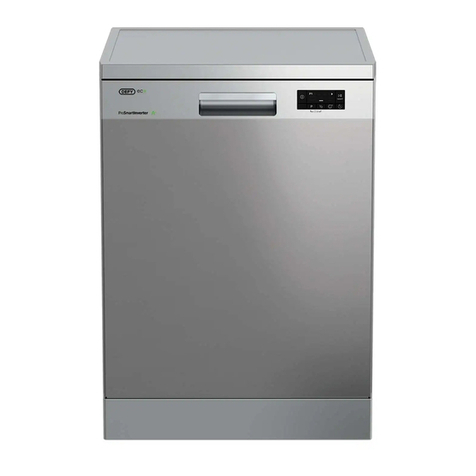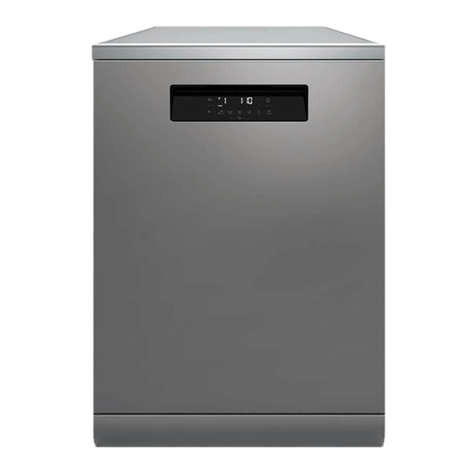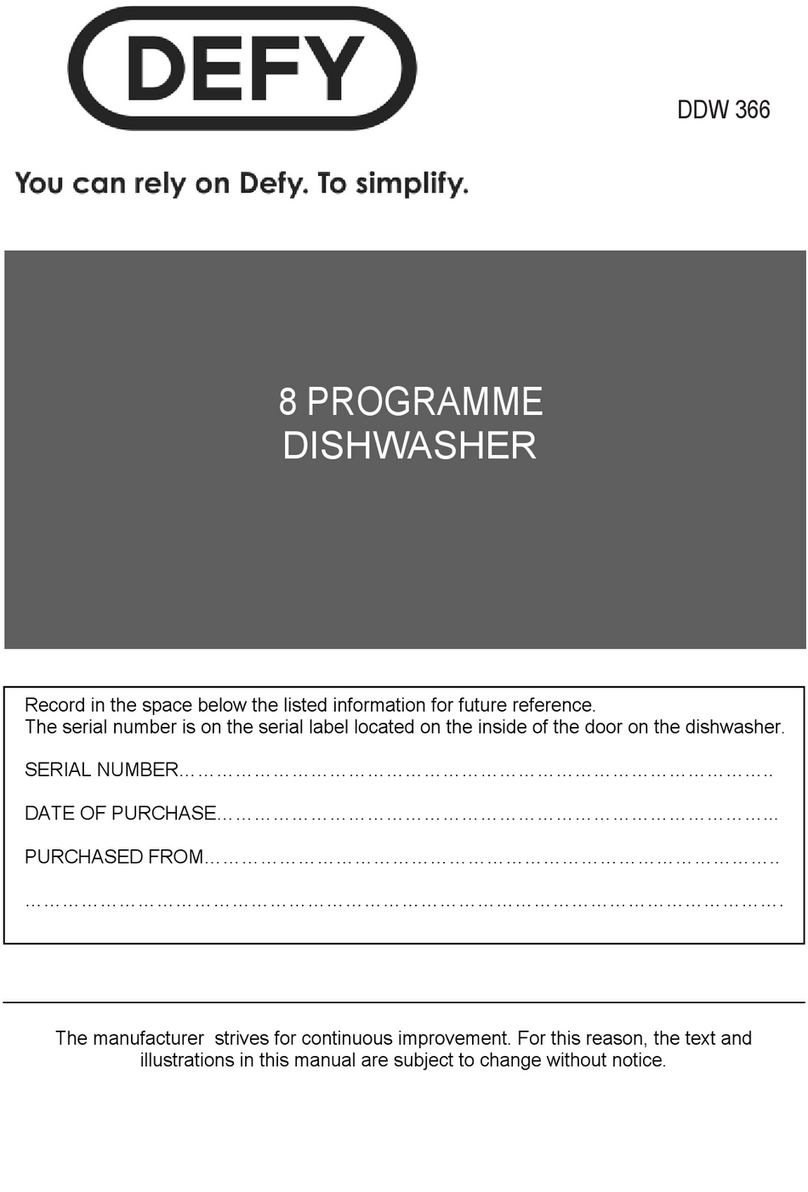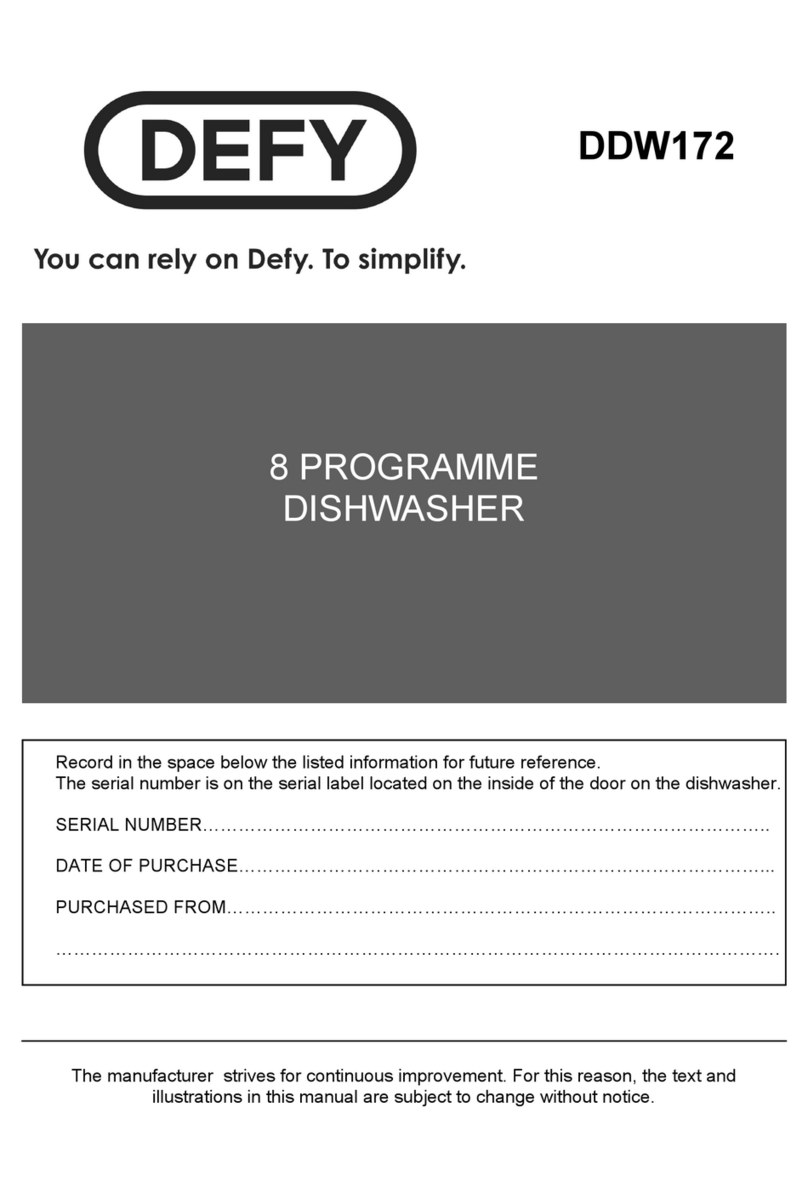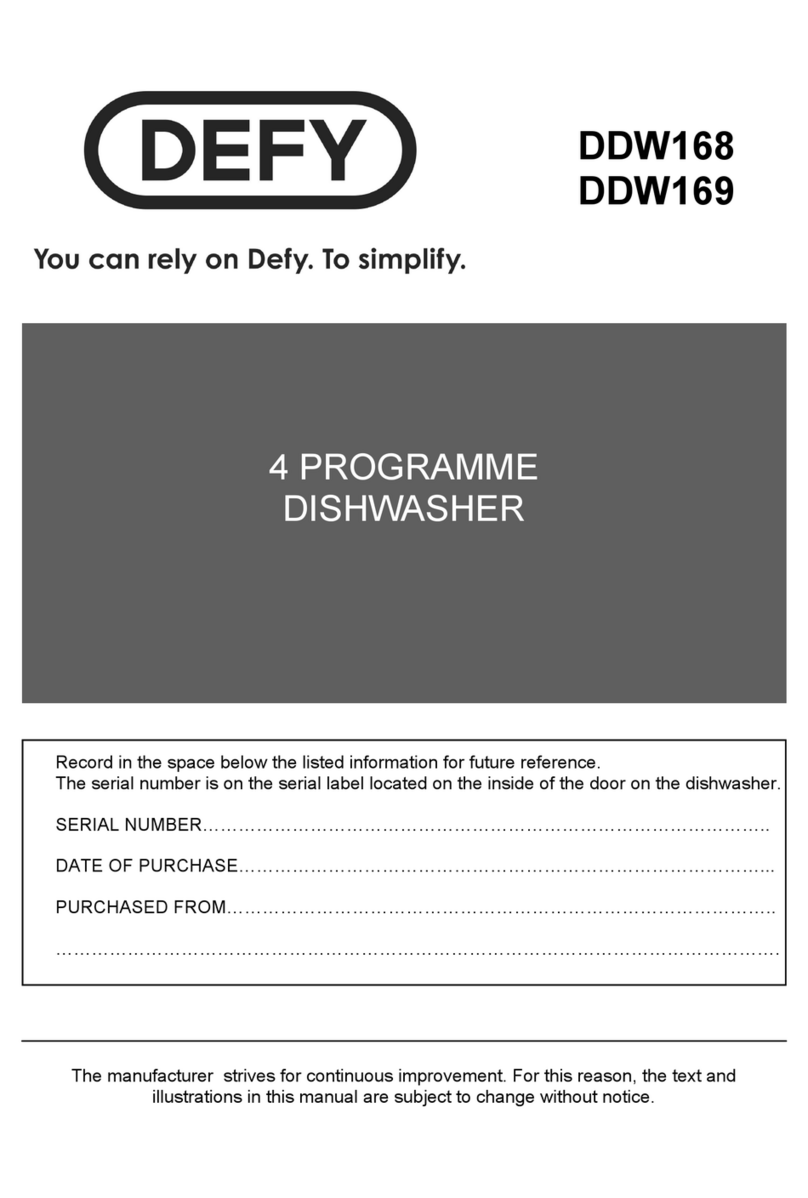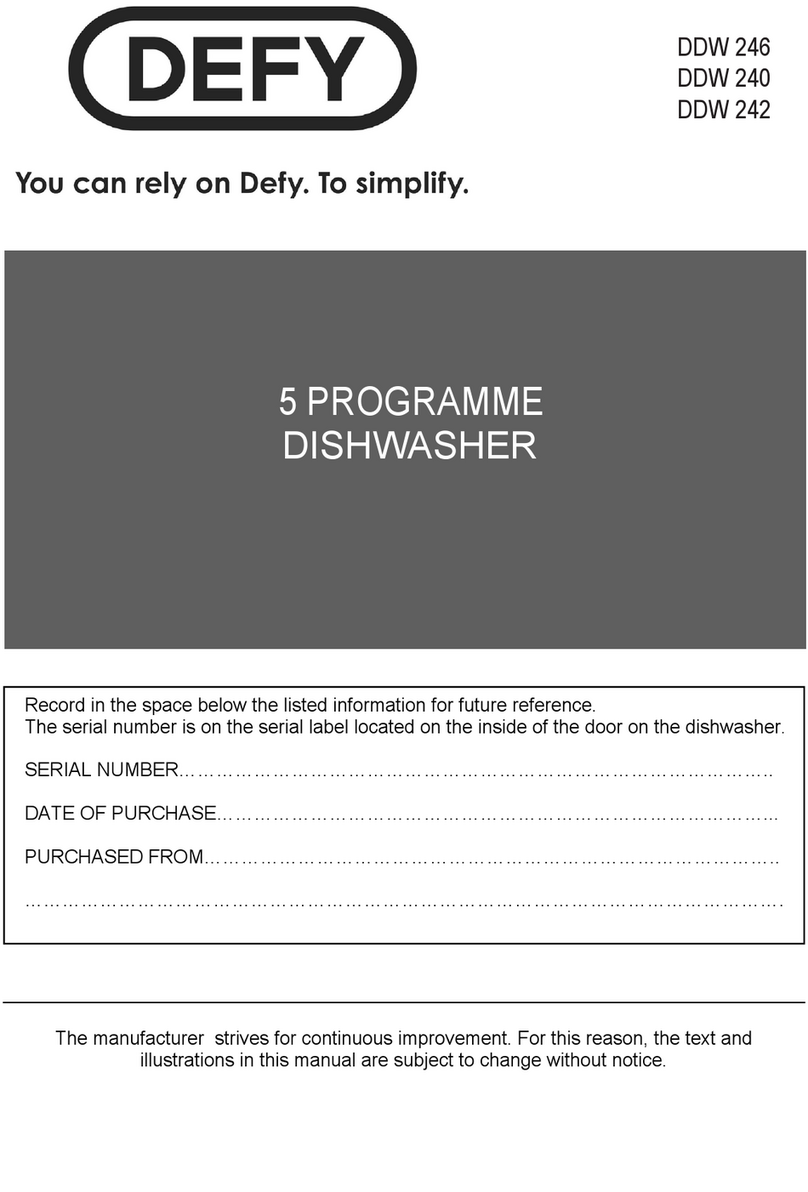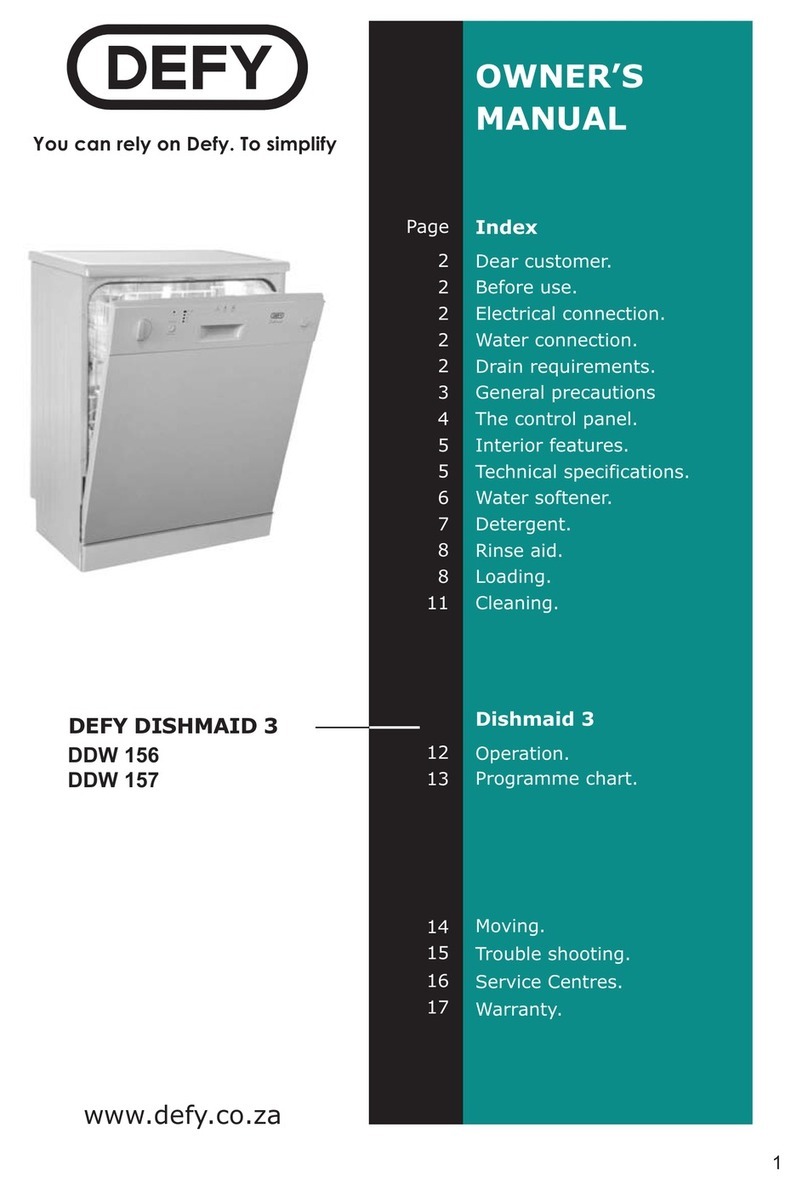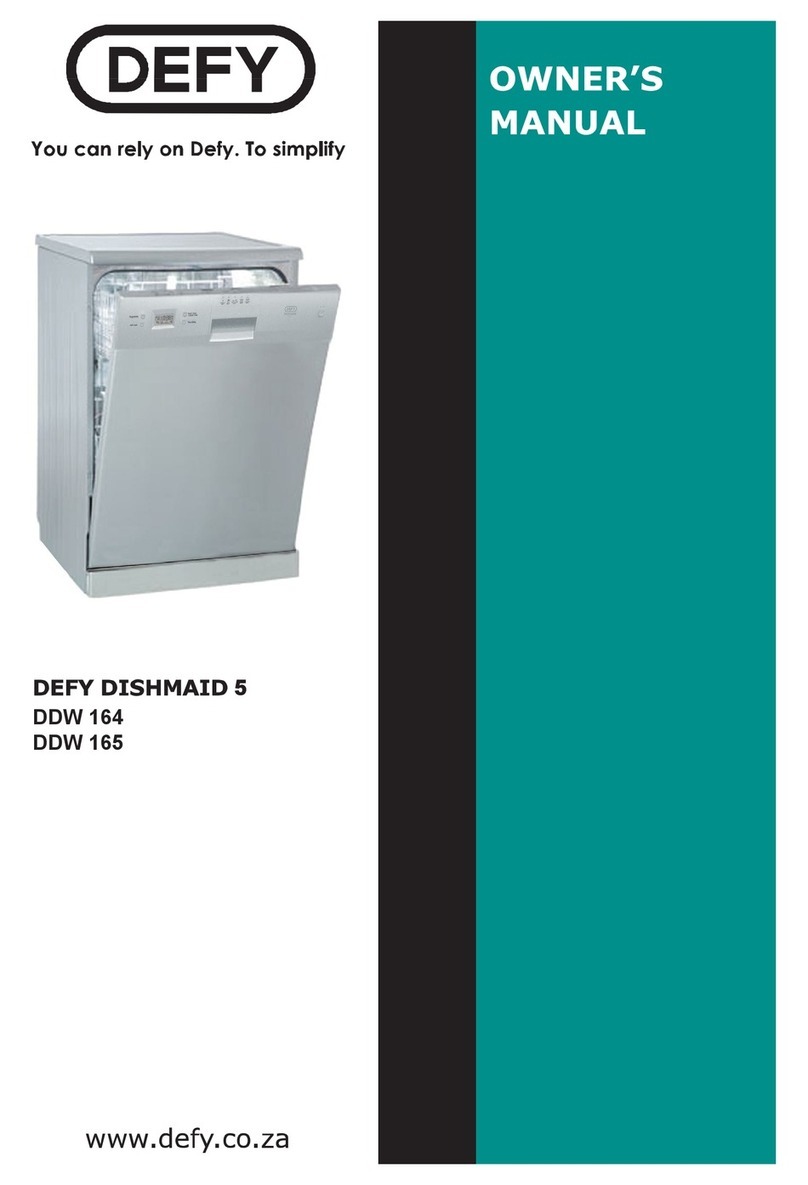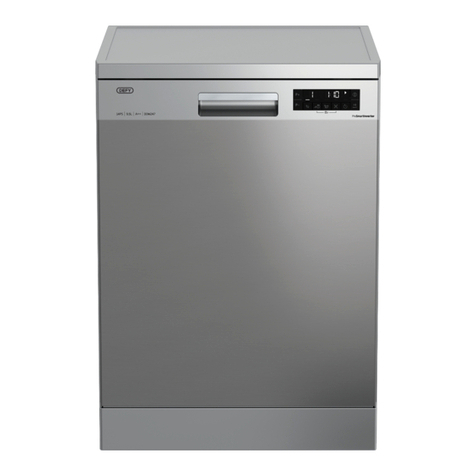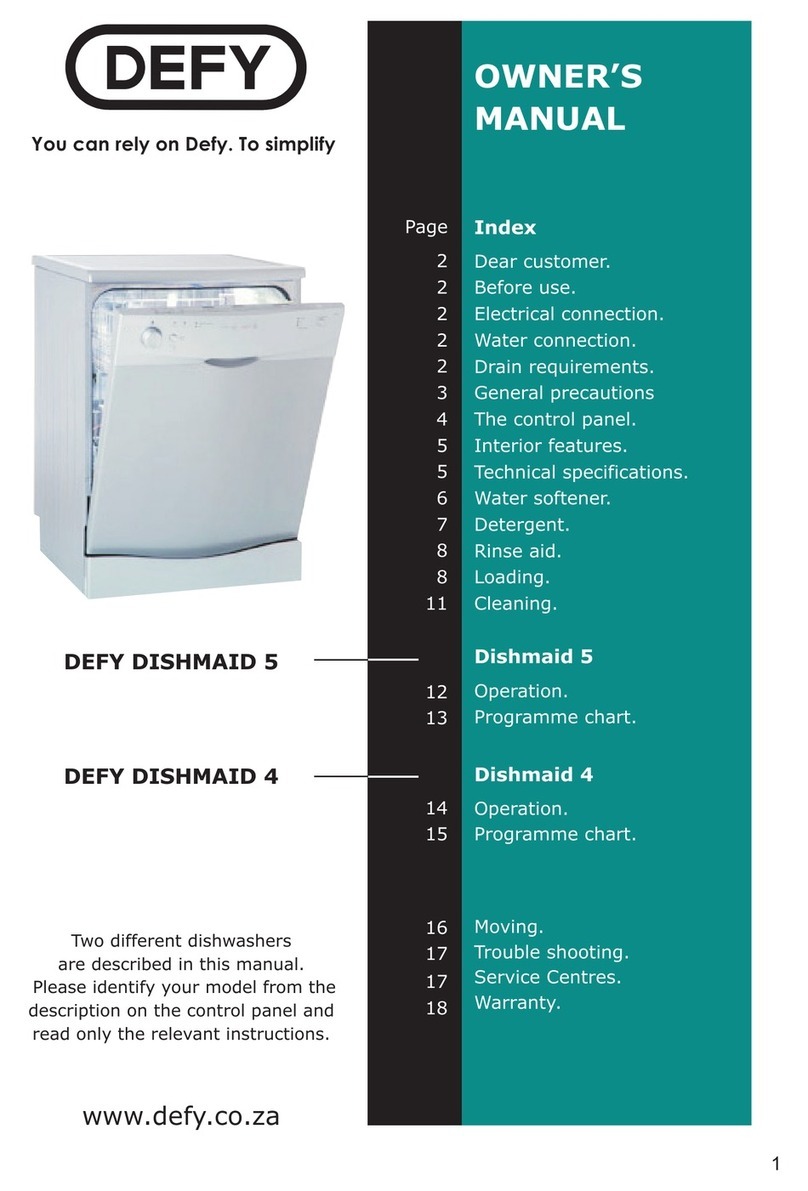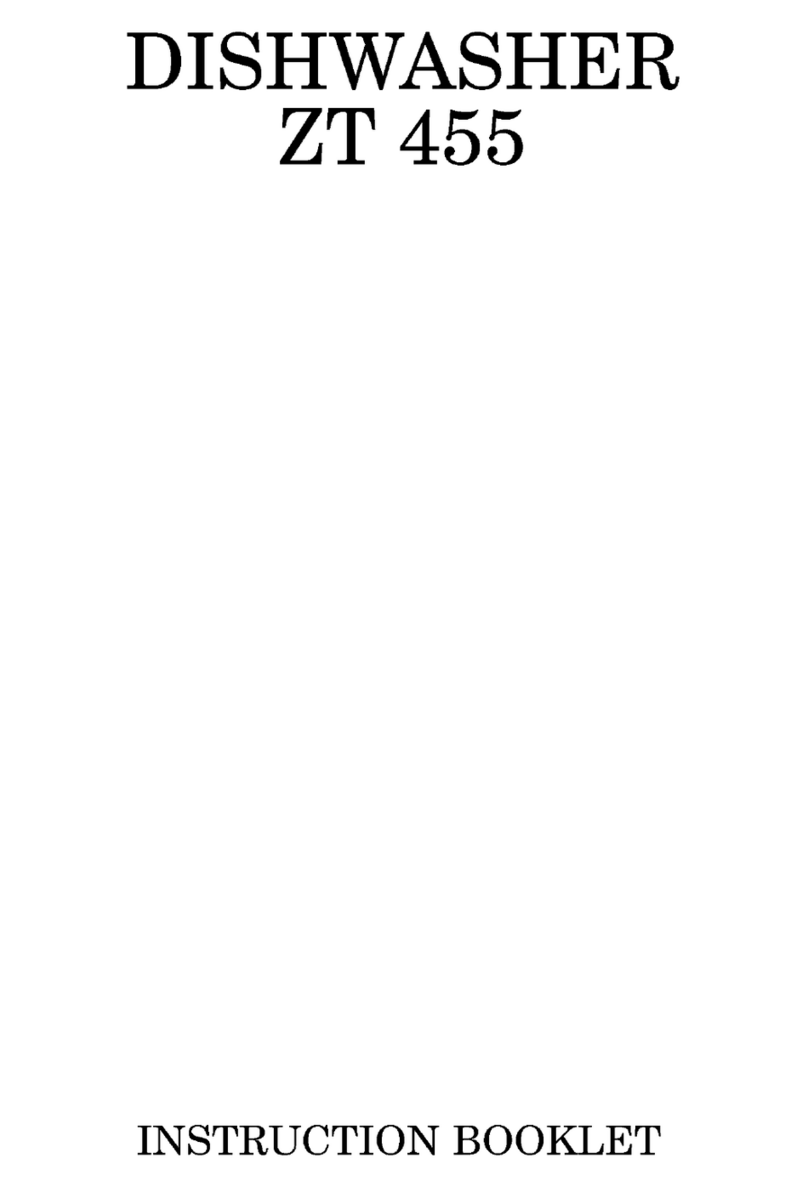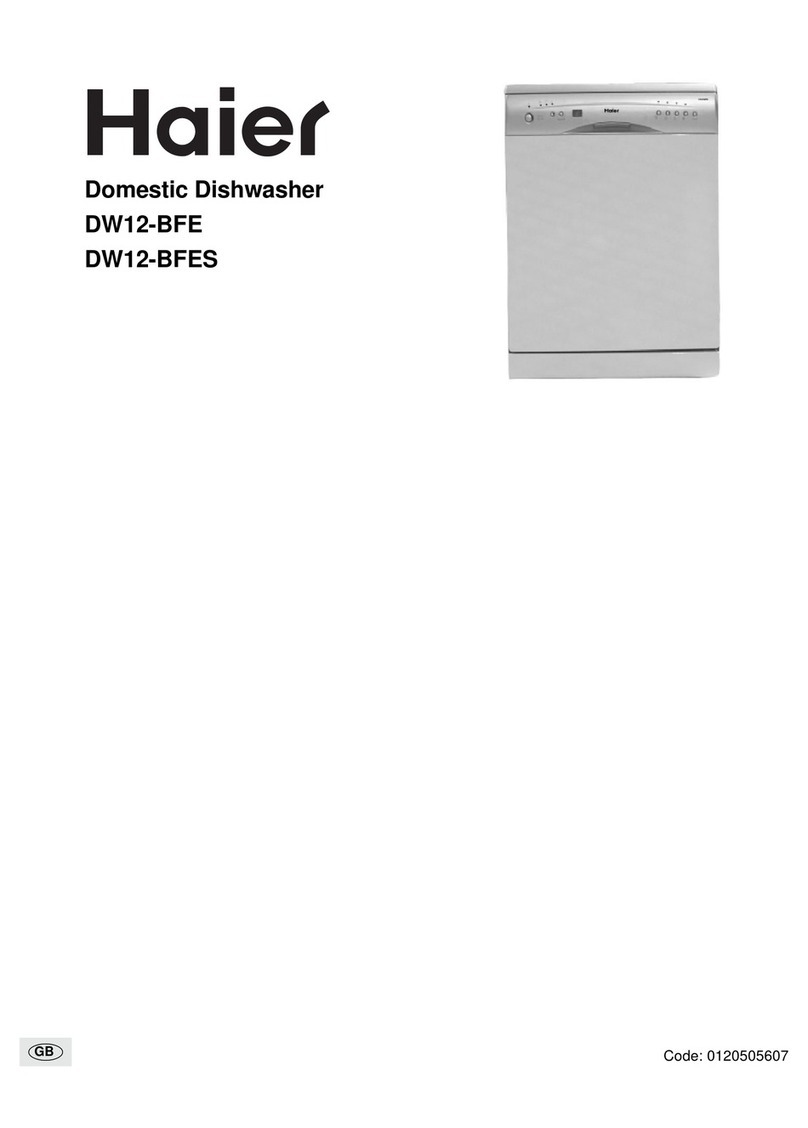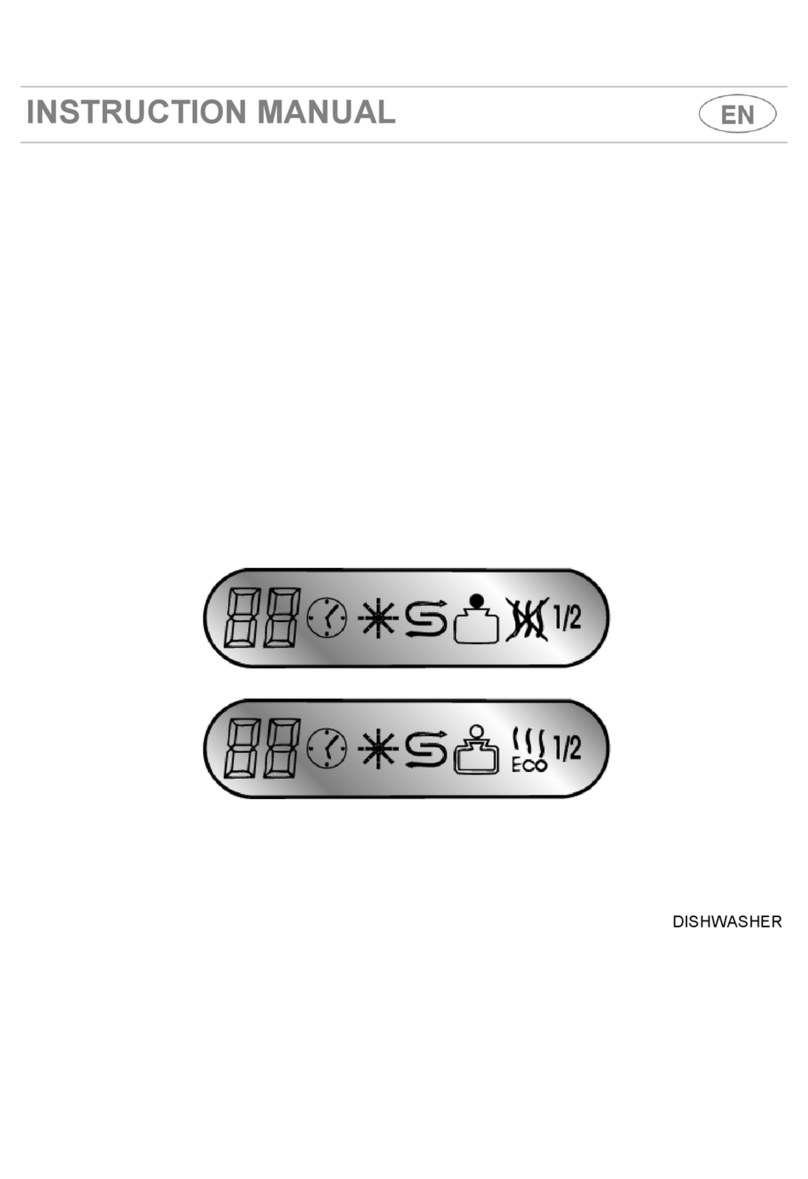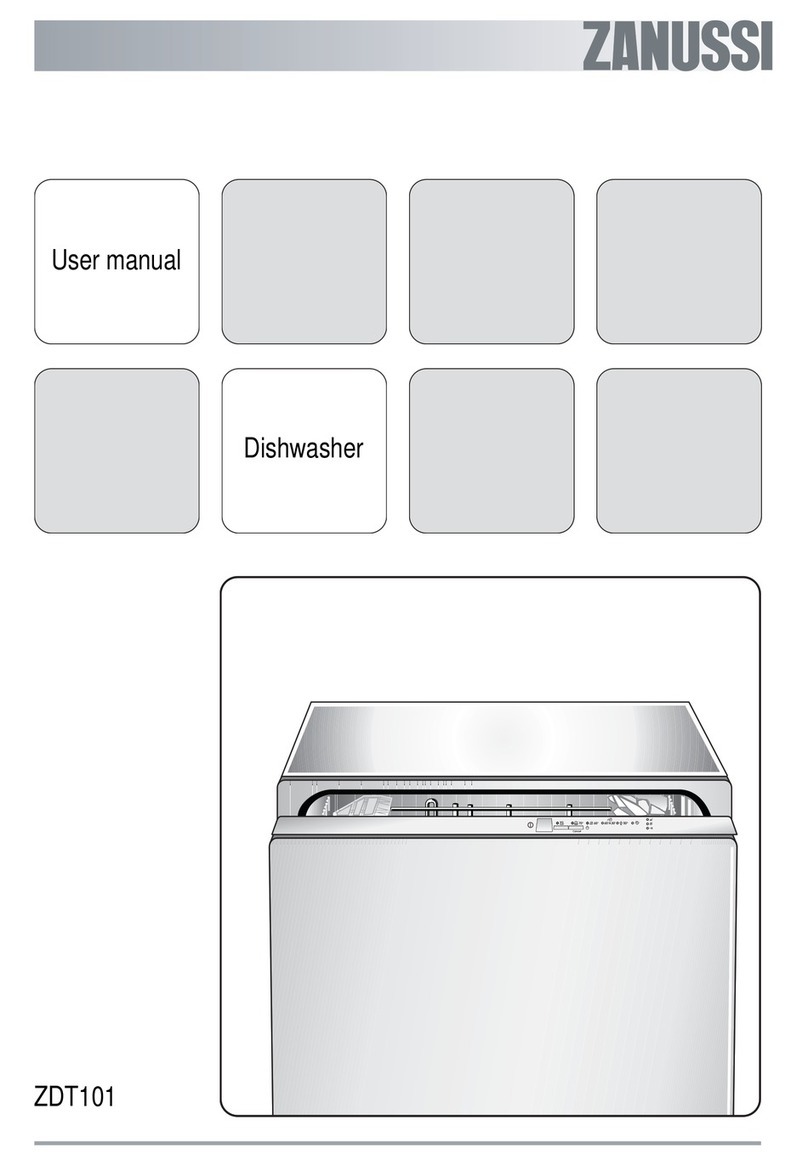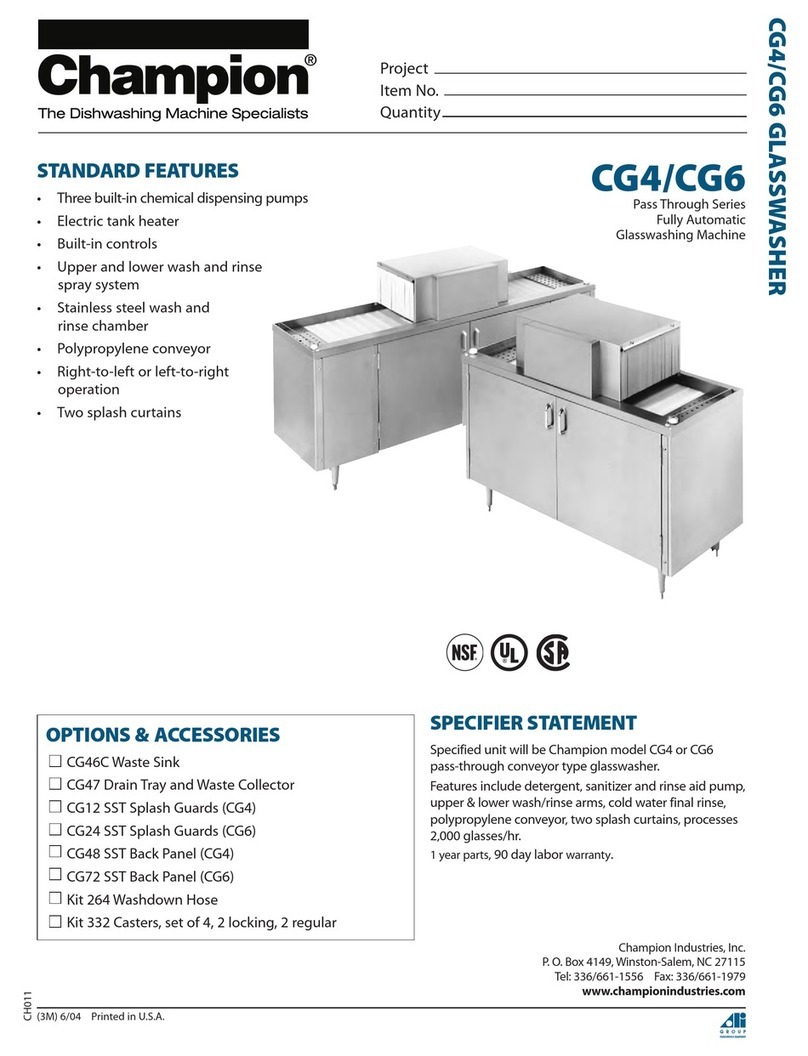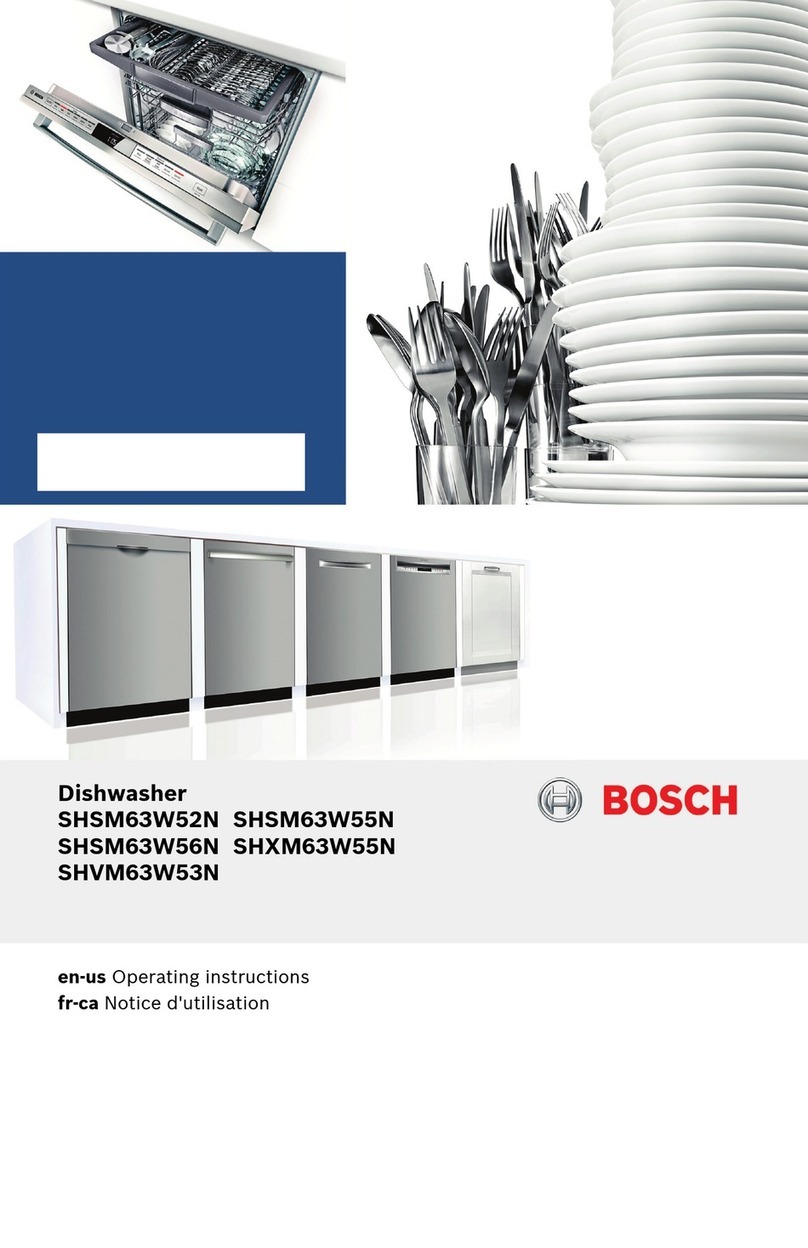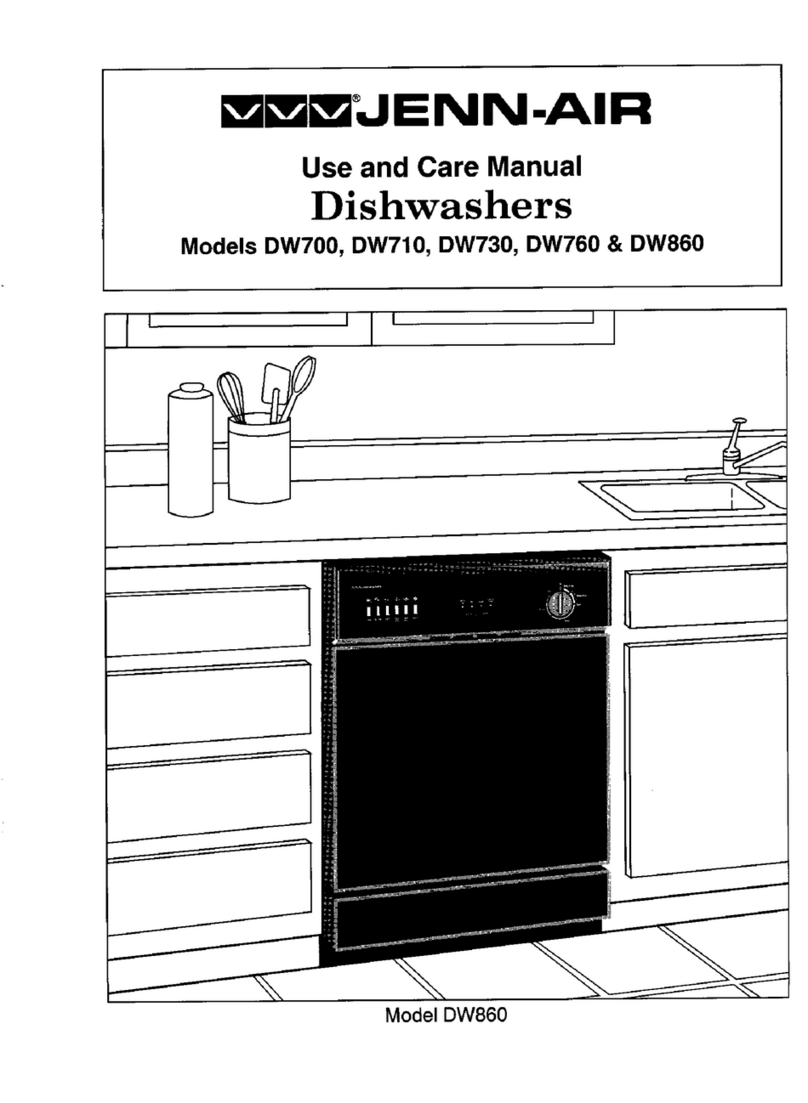Defy DDW 170 User manual

Page 1
DDW170
DDW171
Record in the space below the listed information for future reference.
The serial number is on the serial label located on the inside of the door on the dishwasher.
SERIAL NUMBER ..
DATE OF PURCHASE ...
PURCHASED FROM ..
.
6 PROGRAMME
DISHWASHER
The manufacturer strives for continuous improvement. For this reason, the text and
illustrations in this manual are subject to change without notice.

Page 2
INDEX
Introduction
Explanation of symbols
Register your product
Important safety precautions
Get to now your dishwasher
Before use
Unpac ing
Report damage
Preparation
Installation
Electrical installation
Water connection
Drain requirements
Adding water softener
Adding rinse aid
Adding detergent
Loading dishes, cutlery & pots
Loading options
Loading options continued
Bas et adjustment
Storage
Cutlery bas et
How not to load
The control panel
Description of controls
On / Off
Start / Pause / Cancel
Programme selector
Half load
Tablet detergent
Delayed start
Adding functions
Progress indicators
Cancelling a programme
Changing a programme
Salt indicator
Rinse aid indicator
Operating the dishwasher
Programme table
Cleaning the cabinet
Cleaning the filters
Cleaning the spray arms
Trouble shooting
Technical specifications
Owners responsibility
Service Centres
Warranty
PAGE
2
2
2
3
4
5
5
5
5
5
5
5
5
6
7
8
9
10
11
12
13
13
13
14
15
15
15
15
15
15
15
16
16
16
16
16
16
17
18
19
19
19
20
22
22
23
24
Introduction
Dear customer,
Your new Defy dishwasher was
manufactured in a state of the art facility
and has passed the strictest quality
control procedures.
Please read this manual carefully before
using your dishwasher for the first time
and then store it within easy reach for
future reference.
This manual will provide you with
information on how to operate and care
for your dishwasher to gain the maximum
benefit from it.
We trust you will enjoy years of trouble
free use.
EXPLANATION OF SYMBOLS
Important information
Warning—Hazardous situations
Warning—Electric shock
PLEASE REGISTER YOUR PRODUCT AT
www.defy.co.za
DEFY APPLIANCES (PTY) LTD
P.O.BOX 12004
JACOBS
DURBAN
4026
SOUTH AFRICA
1

Page 3
CHILDREN
This dishwasher is not intended for use by persons (including children) with reduced physical,
sensory or mental capabilities or lack of experience and knowledge unless they have been
given supervision or instruction concerning the use of the dishwasher by a person responsible
for their safety. Children should be supervised to ensure that they do not play with the
dishwasher.
• Keep detergents out of reach. Only put them into the machine just before starting a wash.
• Dishwasher water is not suitable for drinking.
• Never allow children to play on or sit on the door when it is open.
• Please ensure that packaging material is disposed of in a responsible manner. Plastic bags
should be cut up to prevent children playing with them and accidentally suffocating.
SAFETY
• The dishwasher must be installed and connected in accordance with the manufacturer’s
instructions.
• Never place the dishwasher on a carpeted floor. Lack of airflow beneath the dishwasher
could cause overheating.
• The dishwasher must only be used domestically and for the purposes for which it was
designed.
• Do not leave the dishwasher exposed to direct sunlight or rain.
• Never add chemical solvents or flammable liquids to the tank as they constitute a fire
hazard.
• Only use detergents and water softeners specifically manufactured for use in dishwashers.
• The door of the dishwasher has been designed to support the weight of a fully loaded lower
rack. Never place any other load on the door as the dishwasher may then tip forwards.
• Should you at any time in the future scrap the dishwasher, cut the power cord and take
measures to render the door lock inoperative thereby preventing children, when playing,
getting trapped inside.
• In case of malfunction or maintenance work, disconnect the dishwasher from the electrical
mains immediately.
ENVIRONMENTAL CARE
You can save water by observing these simple guidelines:
• Remove bones and pips from dirty dishes.
• Avoid partial loads and only start the dishwasher when it is fully loaded.
• Only use the pre-wash programme for very dirty dishes.
• Select the programme according to the dirt level of the load.
DISHWARE GUIDE Ascertain that your dinnerware and cutlery is dishwasher compatible.
The following should not be washed in a dishwasher:
Rust sensitive steel items. Cutlery with wooden or horn handles.
Non heat resistant plastic items.
No glued dishes or cutlery.
No items made out of copper or tin.
Aluminium and silver tends to discolour.
Sensitive decorated glasses and porcelain parts.
Lead crystal glassware may lose its shine over time.
Art and craft items.
Sponges and dishcloths.
Do not wash articles soiled with cigarette ash, candle wax, varnish, paints or chemicals.
Important safety instructions
2

Page 4
1. Wor top (depends on model)
2. Upper spray arm
3. Lower bas et
4. Lower spray arm
5. Filters
6. Control panel
7. Door
8. Detergent dispenser
9. Lower spray arm slot
10. Cutlery bas et
11. Salt reservoir lid
12. Upper bas et rail
13. Upper bas et with rac
14. Fan drying system ( depends on model)
Get to now your dishwasher
3
Figures represented in this instruction manual are schematic and may not correspond
exactly with your dishwasher. If the parts are not included in the dishwasher you have
purchased, they may be model specific and therefore only valid for certain models.

Page 5
UNPACKING
• Remove all packaging material, accessories and documentation from the dishwasher.
DAMAGE
• Do not use the dishwasher if it has been damaged in transit. Report the damage to your
dealer, who will take the necessary corrective action.
POSITIONING THE MACHINE
• The dishwasher should be positioned close to a cold water tap and a drain outlet.
• After positioning the dishwasher, adjust the feet by turning them in or out to level the unit.
PREPARATION
• Every dishwasher is tested and run in the factory before being dispatched. Before washing
dishes for the first time, it is advisable therefore to first complete a pre-wash cycle to flush
any factory related residuals from the system.
ELECTRICAL INSTALLATION
• The dishwasher must be earthed and the manufacturer and seller do not accept
responsibility for any damage due to incorrect electrical connection.
• .The machine should be plugged into a 15 Amp, 230 Volt 50 Hz earthed 3 pin wall socket.
• For safety reasons, the wall socket and the plug should be accessible after installation.
If the power cord should ever need replacing, use only a genuine cord available from the
nearest Defy Service Centre. Repairs should only be made by a qualified technician.
WATER CONNECTION
• Use a screw on hose connector to secure the filler hose to a 3/4 inch threaded cold water tap.
• The water supply pressure must be between 30 kPa and 1Mpa..
• If the supply plumbing is new or has not been used for some time, it is advisable to run the water
until it is clear and free from dirt. We recommend fitting a filter to the water tap to prevent
impurities such as sand or rust from entering the washer.
• Do not use an old hose and only use the hose supplied with the dishwasher.
• Ensure that the inlet hose is not twisted, bent or squeezed shut.
• There are two different types of water inlet hoses: Cold water inlet hose (up to 25°C) and
hot water inlet hose (up to 60°C). Please check which one is applicable to your model.
Before use
4
Installation
5
DRAIN REQUIREMENTS
• Secure the end of the drain hose to a
drain pipe with an inside diameter of at
least 4cm.
• The outlet end of the drain pipe should be
between 50cm and 100cm above ground
level.
• Do not use an old hose and only use the
hose supplied with the dishwasher.
• Take care not to kink, twist or squeeze the
drain hose.

Page 6
Adding water softener (dishwasher salt)
6
The dishwasher requires lime free water for
optimum operation. The water supply in South
Africa varies considerably. Some users have
access to borehole water only, while others are
supplied from reservoirs or dams. Users in urban
areas would not normally require water softeners. It
is advisable therefore to test your water supply.
Check for white spots on glassware. If these
appear, the water used is too hard and requires
softening. Experience will soon show if softening is
required.
Water softener container
The dishwasher is equipped with a salt container
which automatically softens the water The container
needs to be filled with regenerating salts specially
developed for dishwashers. Small grained or
powdered salt is recommended. Do not use table
salt or edible salt as these contain insoluble
substances.
To fill the container proceed as follows:
• Remove the lower basket to improve access.
• Unscrew the lid of the salt container. (fig A-B)
• If used for the first time, pour about 1 litre of
water into the container. (fig C) If the container
has water in it this step is not required.
• Using the funnel supplied, add salt until the
container is full. (fig D) The container holds about
2 kg of salt.
• Screw the lid back on until a “click” sound is
heard.
To prevent damage which may be caused by spilt
salt solution, we recommend you start a wash
programme immediately after filling the salt
container.
The low salt indicator light on the control panel will
glow when the salt needs replenishing.
Note:
The salt indicator may glow for some time after
filling the container This depends on the time it
takes to dissolve all of the added salt and may take
a few hours.

Page 7
Note:
• Only use rinse aid specifically intended
for dishwashers.
• If composite detergent tablets
containing rinse aid ( 3 in 1 or 2 in 1 )
are used, it is not necessary to fill the
rinse aid dispenser.
Rinse aid prevents water and calcium
streaking on dishes and speeds up the drying
process.
The rinse aid dispenser is to the right of the
detergent compartment.
To add rinse aid, proceed as follows:
• Open the rinse aid dispenser by pressing
the locking lever. (B)
• Carefully pour the rinse aid into the
dispenser to the MAX mark.
• Close the lid.
• Carefully wipe off any spilt rinse aid.
• The dispenser regulator (4) may be set
between 1 and 6.
If lime mar s appear after washing,
select a lower setting.
If water mar s appear after washing
select a higher one.
A rinse aid sight glass (3) allows inspection
of the rise aid level in the dispenser. If the
rinse aid appears to be diluted or is lighter in
colour, it needs to be replenished.
Adding rinse aid
7

Page 8
Adding detergent
8 Only use detergents formulated for use in
dishwashers.
Detergent tablets or composite tablets
containing detergent, softener and rinse
aid may also be used.
The detergent and rinse aid dispensers are
on the inside of the door.
The detergent compartment is on the left.
Open the detergent compartment by pushing
the locking lever to the right (A). Add
detergent before each wash and close the
lid.
The lines on the inside of the detergent
container assist in measuring the correct
amount of detergent. The container can hold
40cm³ of detergent.(1)
For a full load and relatively dirty dishes , fill
the container to the 25cm³ mark.
For slightly soiled dishes and a partial load,
fill the compartment to the 15cm³ mark.
If detergent tablets are used, these should be
placed in the detergent dispenser.
If food particles are stuck and the dishes
have not been washed for a long time,
supplement the detergent by adding an
additional amount to the open oval
depression to the right of the detergent
compartment.(2)
During the wash programme, the detergent
will be dispensed automatically and the lid
will be left open. The best washing results
are obtained using detergent, rinse aid and
water softening salts.
Multi purpose tablet detergents are
available and can give satisfactory results.
These are classified as follows:
2 in 1: Contain detergent and rinse aid or
water softening salt.
3 in 1: Contain detergent, rinse aid, water
softening salt.
4 in 1: Contain detergent, rinse aid, water
softening salt and a glass protector.
5 in 1: Contain detergent, rinse aid, water
softening salt, a glass protector and a
stainless steel protector.
Do not use tablet detergents in short
programmes since their total solubility is
dependent on temperature and time.

Page 9
The dishwasher has a 12 place setting
capacity including serving dishes.
Loading guide.
• Remove coarse food leftovers.
• Place all containers such as cups, glasses
and pots with the opening facing down so
that no water can collect.
• Dishes and cutlery may not be placed
above each other.
• Do not allow glasses, cups and fragile items
to touch each other.
• Small and light items can be placed in the
upper basket.
• Place all large and very dirty items in the
lower basket.
• The basket features glass holder flaps.
These may be folded up to create more
space for larger items.
• Place forks, spoons and knives in the
special cutlery basket. Knives and other
utensils with sharp points must be loaded in
the basket with their points facing down.
• The movement of the spray arms should not
be hindered.
• Do not overload the dishwasher.
After a few washes you will know which
loading positions suit you best.
Loading dishes, cutlery & pots
9

Page 10
Loading Options
9A
Depending your model of dishwasher you
may have any of the following storage
options available to you.
1 .COLLAPSIBLE LOWER BASKET WIRES
(2 pieces) or (4 pieces)
A larger storage space may be created by
pressing latch (A) and folding the wires
down.
2 LOWER BASKET BOTTLE WIRE
(Depends on model)
Long items with a wide opening such as jars,
may be stored upright over the bottle wire.
Locate the wire as shown.
The bottle wire may be removed when not in
use.
3 LOWER BASKET MULTI PURPOSE
RACK (Depends on model)
Located on the lower basket, the rack
enables the storage of extra glasses or long
items such as ladles and carving knives.
To close rac
• Fold rack (A)
• Slide the rack up (B)
• Set rack to vertical position (C)
• Slide rack down and lock with tab (D)
To adjust the height of the rac s
• Fold rack (E)
• Slide rack up (F)
• Open rack at desired level (G)
(Depends
on model)
(Depends on model)
(Depends on model)

Page 11
Loading Options
9A
4 UPPER BASKET HEIGHT ADJUSTABLE
RACK
• These may be adjusted up or down
depending on the height of cups or
glasses to be washed
• (A, B, C)
5 UPPER BASKET DRAWER
(Depends on model)
• Additional small for s , nives and
spoons may be placed in the bas et
drawer.
6 UPPER BASKET GLASS SUPPORT
(Depends on model)
• Do not lean long stemmed wine glasses
against each other or against the basket
edge. Use the glass support instead.
• It may be adjusted by releasing and
relocating the tabs to create a larger
space.
7 COLLAPSIBLE WIRES UPPER BASKET
(type A) (Depends on model)
The wires may be folded flat to create a
larger space.
Grab the first wire and adjust to fold or raise
the wires.
7 COLLAPSIBLE WIRES UPPER BASKET
(type B)
The wires may be folded flat to create a
larger space.
Press on the tab to lay the wires down thus
creating more available space.

Page 12
The upper bas et may be lowered to facilitate the loading of larger items. The
adjustment method varies from model to model and you should chec which method is
pertinent to your machine.
1
Release the latches on both the right and left tracks by opening them sideways.
Roll the basket forwards to remove it.
Reposition the basket so that the upper set of rollers engage in the tracks and close the
latches.
2
The basket , even fully loaded, may be adjusted without removing it from the machine.
The “elevator system’ at either side has a blue retainer. Grab one of the upper basket wires,
(left or right) and lift up (A). Repeat on other side. To lower the basket, press the latch on the
basket adjustment mechanism. (B)
3
Upper bas et adjustment
10
(Depends
on model)
(Depends
on model)

Page 13
Storage
11
Different cutlery bas ets are supplied, depending on the model
These may be removed to provide additional storage space
The following pictures illustrate how not to load the bas ets

Page 14
1. On / Off button
2. Start / Pause / Cancel button
3. Display
4. Programme selection button
5.Half load button Tablet detergent button
6.Delayed start button
7.Door handle
14. Half load / Tablet detergent indicator
15. Progress indicator
a = Washing indicator
b = Drying indicator
c = End of programme indicator
8. Programme indicator
9. Salt indicator
10. Rinse aid indicator
11. Remaining time / Delay time indicator
12. Start indicator
13. Delayed start indicator
The control panel
12

Page 15
ON/OFF button (1)
• When the On/Off button (1) is pressed, the
display switches on and shows the last
programme used.
• If you wish to disable this programme and
select a new one, you should do so at this
time before pressing the Start/Pause/
Cancel button.
• Pressing the On/Off button once more
switches the dishwasher off and the
display dims.
START/PAUSE/CANCEL button (2)
Pressing this button, Starts, Pauses or
Cancels a selected programme. It is also
used to cancel a delayed start countdown.
• Wait for two seconds to view the full
display after switching the machine on.
• The selected programme will commence
operating when the Start/Pause/Cancel
button (2) is pressed.
• The start indicator (12) will light up.
PROGRAMME SELECTION button (4)
• Press this button to select the programme
you wish to use. (see programme table in
this book )
• The programme number appears in the
programme indicator display.(8) and will
advance by one every time the button is
pressed.
• The selected programme will start when
the Start/Pause/Cancel button(2) is
pressed.
• The time indicator (11) will display the
estimated time remaining to the end of the
programme.
• Note:The total time can differ from the time
initially displayed as it can change during
the programme, depending on ambient
water temperature, the size of the load
and the regeneration of the water
softening system.
HALF LOAD button (5)
Use this setting if you wish to run the
machine without fully loading it.
• Press the On/Off button.
• Press the programme selection button to
select the desired programme.
• Press the half load button
• The 1/2 load indicator (14) is displayed.
• Press the Start/Pause/Cancel button to
start the programme.
TABLET DETERGENT button (5)
• Depending on the hardness of the tap
water, pressing this button enables
optimum use of the tablet’s characteristics.
Salt and Rinse aid indicators switch off
when this function is selected.
• Switch the dishwasher on by pressing the
On/ Off button.
• Close the door
• Select the desired programme
• Press the Half load / Tablet detergent
button
• The Half load indicator will switch on
• Press the Start/Pause/Cancel button
Using the Half load and Tablet detergent
functions concurrently
• Switch the dishwasher on by pressing the
On/ Off button.
• Press the Half load / Tablet detergent
button until both the Half load and Tablet
detergent indicators switch on.
The dishwasher will remember the last
programme setting the next time you wish to
use it. If you wish to then cancel the Half
load / Tablet detergent programme, press the
button until the indicators switch off.
DELAYED START button(6)
• This is particularly useful if you wish the
dishwasher to operate at a convenient
time other than the present moment.
• Each time the button is pressed, the
programme start time is delayed by one
hour up to a maximum of nine hours.
• The delayed start indicator (13) will flash.
• Press the Start/Pause/Cancel button after
the delayed start time has been set.
• Time will be counted down in the display
(11)
• The programme will start automatically at
the end of the countdown.
Description of controls
13

Page 16
ADDING FUNCTIONS TO THE
PROGRAMME
Half load and delayed start can be added to
an existing programme as follows:
• Select the programme by pressing the
programme selection button (4).
• Press the function button (5 or 6 or both).
• Start the programme by pressing the
Start/Pause/Cancel button (2).
PROGRESS INDICATOR
The wash cycle may be monitored by
observing the progress indicators (15)
• a= Washing.
• b= Drying.
• c= End of programme.
• At the end of the programme, the indicator
lights up and the remaining time indicator
(3) displays 0:00.
CANCELING A PROGRAMME
• Press the Start/Pause/Cancel button and
hold it down for three seconds to cancel a
programme that is running.
• Release the button when the start
indicator (12) starts flashing.
• After a few minutes. The machine will then
fulfill the necessary cancellation
operation .
• When the remaining time (11) displays
0:00 a new programme may be selected.
NOTE: Depending on when the
programme was cancelled, there may be
detergent and rinse aid residues left in the
machine.
CHANGING A PROGRAMME
• Press the Start/Pause/Cancel button (2) to
pause the machine.
• Select the desired programme by pressing
the programme selection button (4).
• Start the new programme by pressing the
Start/Pause/Cancel button (2) again.
The new programme will start where the
previous one left off. For example if the
previous one was in a rinse cycle, the new
one will resume in a rinse cycle. If you wish
the new programme to start from the
beginning ,you will first have to cancel the
previous programme as described under
‘Canceling a programme.
SALT INDICATOR (9)
• Please check the indicator (9) regularly.
If it lights up, the salt needs to be
replenished.
SETTING THE RINSE AID INDICATOR (10)
Using the rise aid indicator is optional and
this function may be switched on or off.
Proceed as follows:
• The machine must be switched off.
• Press and hold the 1/2 load button (5)
and then press the ON/OFF button (1)
to switch on.
• Keep the 1/2 load button pressed in and
release the ON/OFF button.
• Hold the 1/2 load button in for an
additional 3 seconds.
• The Rinse aid indicator (10) will come
on and the stored status appears on the
display as ON or OFF.
• You can change this status using the
Start/Pause/Cancel button .
• Depending on the status ON or OFF
when the machine is switched off, it will
remember the setting and either utilize
the indicator or not when next the
machine is switched on.
RINSE AID INDICATOR (10)
• Please check the indicator (10)
regularly.
• If it lights up, the rinse aid needs to be
replenished.
• If the status of the indicator is OFF, it
will not show even if the rinse aid
container is empty.

Page 17
OPERATING THE DISHWASHER.
• Plug the mains plug into a dedicated 15A
earthed wall socket.
• Open the water tap.
• Open the dishwasher door.
• Load the dishes.
• Check if both the upper and lower spray
arms rotate freely.
• Add the required amount of detergent to
the dispenser and close the dispenser lid.
• Close the dishwasher door.
• Press the ON/OFF button
• Check to see if water softening salt and/or
rinse aid need replenishing.
• Select the desired washing programme.
• Start the programme by pressing the Start/
Stop/Cancel button.
• Monitor progress via the time remaining
display and the progress indicators.
• The End of programme indicator will light
up.
• Switch the machine off by pressing the
ON/Off button.
• Close the water tap. (optional)
• Remove the plug from the wall socket
(optional).
• Open the door slightly and allow the
dishes to cool for about 15 minutes before
removing them.
• The Door should not be left in the fully
open position as this could present a
tripping hazard.
• Thereafter the clean dishes may be
removed.
WARNING
• Never open the dishwasher door while it is
running.
• Stop the dishwasher using the Stop/Start/
Cancel button.
• Thereafter the door may be opened
• Be careful to avoid the rush of hot steam
which may escape.
• Fix whatever required fixing or which
necessitated the door being opened.
• Close the door and press the Start/Pause/
Cancel button again.
The dishwasher will then resume operation.
Operating the dishwasher
14

Page 18
Programme table
15
The consumption values shown in the table were determined under standard conditions. Differences may therefore occur under practical conditions.
*Reference programme for testing institutes. The testing is in accordance with EN 50242 and must be carried out with a full water softener tank, a full salt dispenser and
a full rinse aid reservoir using the test programme.
Programme 1 2 3 Reference* 4 5 6
Programme name Pre-wash Mini 30 Economy Quick & Clean Intensive Auto
Cleaning temp. — 35°C 50°C 60°C 70°C 40°C to 65°C
Degree of soiling Suitable for
removing the
remnants on soiled
dishes which wait in
the washer for a few
days.
Suitable for lightly
soiled dishes used
daily and scraped
clean
Most economical
programme for
medium soiled dishes
which have been kept
waiting
Fastest way to clean
daily medium soiled
dishes which have
been kept waiting
Suitable for heavily
soiled pots and
pans
Determines the
degree of soil and
sets the temperature,
water level and wash
time automatically
Suitable for all types
of dishes.
—- Little Medium Medium High Med.—High
Detergents
A=25/15cm³
B=5cm³
—- A A+B A+B A+B A
Sequence
without options
Pre-wash
End
Wash
Cold rinse
Hot rinse
End
Pre-wash
Wash
Cold rinse
Hot rinse
Dry End
Wash
Cold rinse
Hot rinse
Dry
End
Pre-wash
Wash
Cold rinse
Hot rinse
Dry
End
Automatically
adjusted to suit
degree of soiling
Duration (minutes) 15 30 155 58 136 62—163
Water (litres) 4 10.2 13 10.2 14.8 10.0 — 16.2
Energy (kWh) —- 0.75 1.02 1.24 1.45 1.05—1.50

Page 19
Always disconnect the appliance from the
Electrical and Water supply before
cleaning.
CLEANING THE CABINET
• Wipe up any detergent, softener and other
spills as they occur with a soft damp cloth.
• Periodically clean the cabinet, the inside of
the door and door gasket with a damp
warm soapy cloth, rinse and dry.
• Clean the control panel using a damp cloth
only.
• Do not use abrasive or corrosive
substances.
CLEANING THE FILTERS
To ensure optimum performance, the filters
should be cleaned regularly.
The machine is equipped with three filters -
Main, Coarse and Micro.
• Remove the lower basket to gain access
to the filters.
• Turn the coarse central filter assembly (A)
in an anti clockwise direction and pull free.
• This allows the Main filter (B) to be lifted
out.
• Press on the two tongues of the coarse
filter to remove the micro filter (C)
• Hold the filters under running water and
clean with a soft bristle brush.
• Carefully replace the main filter
• Insert the reassembled Coarse/Micro filter
assembly in the Main filter and twist it
clockwise until it clicks in place.
• Pull out the bottom filter mesh (B) and
rinse.
CLEANING THE SPRAY ARMS
Dirt or calcium deposits may block the
nozzles on the spray arms. For this reason
they should be cleaned regularly.
• Both spray arms should be removed.
• Remove the lower basket.
• Pull the lower spray arm free (A).
• Loosen the fastening nut on the upper
spray arm and pull the spray arm free (B).
• Flush away any food particles under
running water.
• Re-fit the arms in their original position.
Cleaning
16
Lower
spray arm
Upper spray arm
Do not use the dishwasher without
the filters.
Incorrect placement of the filters will
reduce washing efficiency
Ensure that the filter attached to your
water tap is cleaned regularly. (If fitted)
1. Turn off the tap and remove the hose.
2. Remove the filter and clean it under
running tap water.
3. Seat the filter back into the hose.
4. Refit the hose to the tap.

Page 20
MACHINE DOES NOT START
• Power cable is unplugged. >>> Check if
the power cable plug is securely plugged
in.
• Fuse is blown. >>> Check the fuses in
your house or for a tripped circuit breaker.
• Test the wall socket for power using
another appliance.
• Inspect the electrical cord for damage.
• Eliminate the use of an extension cord, if
any is being used.
• Water is cut off. >>> Make sure that the
water inlet tap is open.
• Door of the dishwasher is open. >>> Make
sure that you have closed the door of the
dishwasher.
• On / Off button is not pressed. >>> Make
sure that you have turned the dishwasher
on by pressing the On / Off button.
DISHES NOT CLEANED PROPERLY
• Load dishes as prescribed.
• Choose a longer programme that washes
at a higher temperature.
• Ensure spray arms are clean and rotate
freely.
• Clean filters as prescribed.
• Do not overload baskets.
• Adjust the amount of detergent.
• We recommend you use tablet detergents
as these are less affected by humidity
during storage.
• Adjust the amount of rinse aid.
• Ensure that the lid of the detergent
dispenser is closed properly.
DISHES NOT DRIED PROPERLY
• Load dishes as prescribed.
• Adjust the amount of rinse aid.
• Choose a longer programme that washes
at a higher temperature.
• Leave the dishwasher door slightly ajar at
the end of the programme and allow the
dishes to cool for at least 15 minutes
before unloading.
• Start unloading from the lower basket.
TEA,COFFEE AND LIPSTICK STAINS
• Choose a longer programme that washes
at a higher temperature.
• Adjust the amount of detergent.
• We recommend you use tablet detergents
as these are less affected by humidity
during storage.
• Do not wash silverware with a heavily
textured surface in the dishwasher
LIME STAINS AND A HAZY APPEARANCE
• Increase the amount of rinse aid
• Water requires more softening . Add more
salt.
RAINBOW / BLUEISH BLUSHING ON
GLASSWARE
• Decrease the amount of rinse aid.
• If your supply water is soft (<5dH) do not
use salt.
• Choose a longer programme that washes
at a higher temperature.
SCRATCHED OR BROKEN GLASSWARE
• Add salt.
• Ensure there is no salt leakage. Clean up
any spilt or residual salt and tighten the
container.
• Do not overload baskets.
• Do not allow glasses to touch.
Trouble shooting
17
This manual suits for next models
1
Table of contents
Other Defy Dishwasher manuals
Popular Dishwasher manuals by other brands
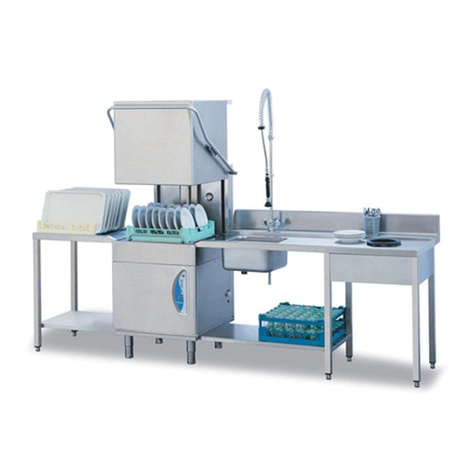
lamber
lamber L21-ek Instructions for the user
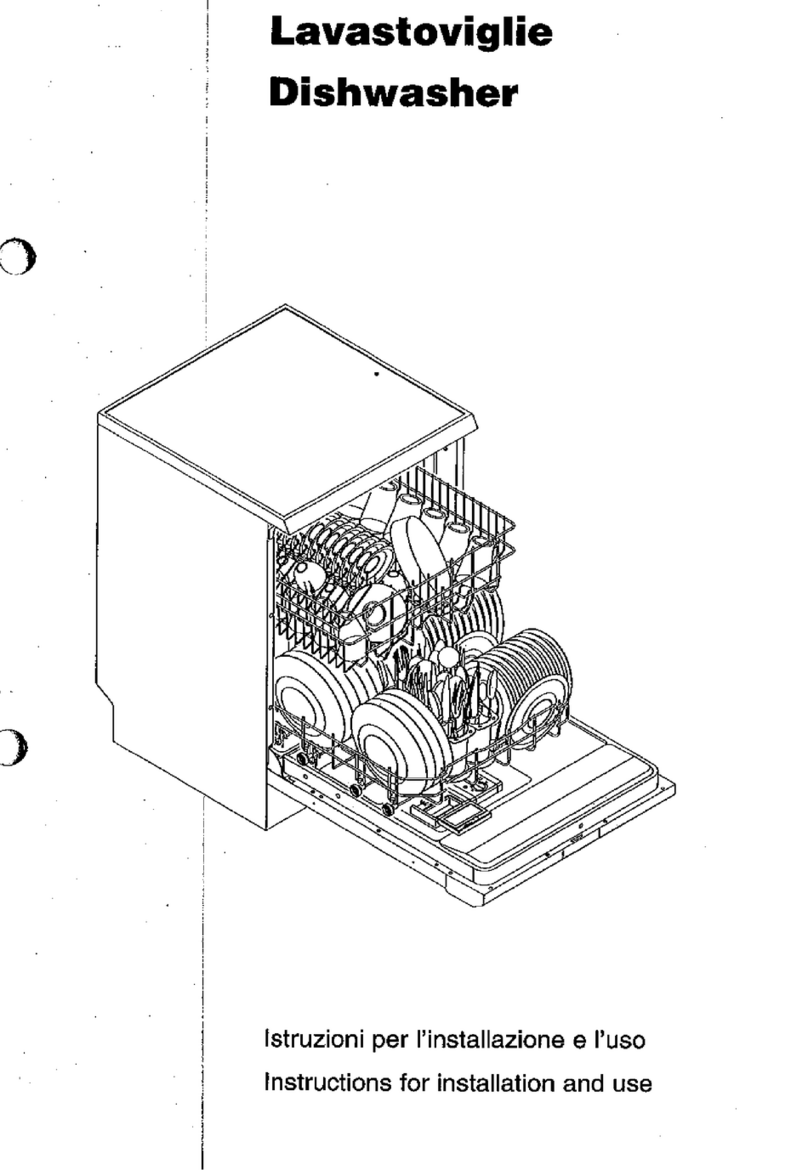
Smeg
Smeg LS300B Instructions for installation and use

AEG Electrolux
AEG Electrolux FAVORIT OPTIMA AA user manual
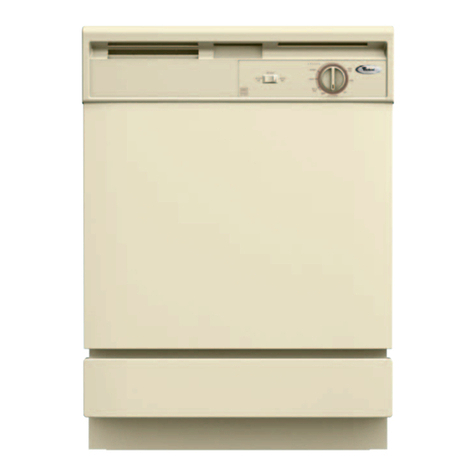
Whirlpool
Whirlpool DU810SWP Features & specifications

Electrolux
Electrolux FAVORIT 50875 user manual
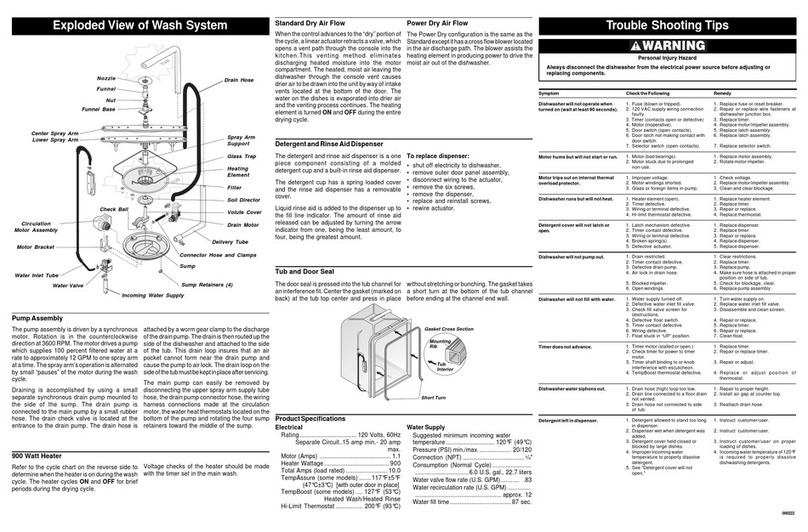
Frigidaire
Frigidaire FDB345LFS2 Service data sheet
